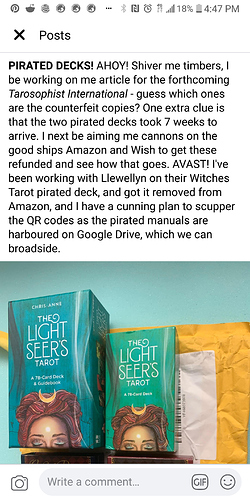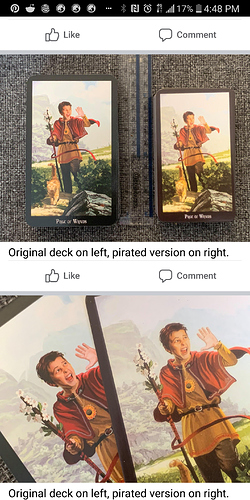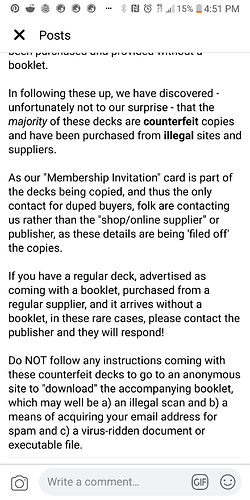| I WANT TO LEARN TAROT. HOW DO I START? | ||
|---|---|---|
Congratulations on your choice to begin learning the art of divination using tarot cards! It’s a hobby with a very enthusiastic base and I hope you find it just as enjoyable.
| CHOOSING A DECK | ||
|---|---|---|
-
You will want to make sure you are selecting a tarot deck and not a similar divination deck such as oracle, lenormand, or cartomancy decks. A tarot deck typically contains 22 major arcana (trump) cards and 56 minor arcana (pips and courts) cards for a total of 78 with the divination meanings being generally consistent across all decks within this system, even if individual card titles differ occasionally.
-
There is a popular myth out there that one has to be gifted a tarot deck. This is complete bullshit. Same with other superstitions about needing to be cleansed in moonlight, never letting other people touch your cards (you shouldn’t because people are gross with disgustingly sticky unidentified substances on their fingers and not because they’ll somehow permanently taint the energy of your deck forever no matter the amount of cleansing), etc.
The one superstition I’d say that’s actually a really good fucking idea is Lady Eva’s suggestion about storing in metal when not in use. I store mine in a drawstring pouch and place inside one of those vintage tin school lunch boxes.
- Be wary of pirated decks. These tend to be counterfeits printed in China. They used to be mostly seen only on EBay, but have become a growing issue on more reputable markets such as Amazon. Pirated decks not only wrongly steal profit from the artists who created these decks, but they also tend to negatively impact the consumers who purchase them as the quality is subpar: offset images, thinner cardstock, less vivid colors, and cards peeling apart are common complaints. You can typically spot these by the fact they are suspiciously cheaper than other listings for the same item and won’t even come with a little white book (LWB) of definitions, instead directing you to a link to download the keyword book.
- There’s three basic styles a tarot deck will be based upon: Tarot de Marseilles, Thoth, and Rider-Waite Smith.
- Tarot de Marseilles (TdM): the oldest of the three. Major Arcana and Court Cards are story illustrated. Pips are not (e.g. this means it is more like a typical deck of cards where the 5 of cups would only show 5 cups on the card). Justice is VIII and Strength is XI in the Major Arcana. An example of this is The Goddess Tarot by Kris Waldherr (note – in the Major Arcana only. She chose to have illustrated pips like RWS for her deck).
From what I can gather, tarot likely started off as an Italian card game called tarocchi and we can thank the 18th century French occultist Eliphas Levi for linking divinatory meanings to the cards as we know them today.
- Thoth: Aleister Crowley’s deck he had commissioned. He made improvements upon Tarot de Marseilles based on his occult knowledge. Major Arcana and Court Cards are story illustrated and pip cards are not.
I’m going to be frank with you – I don’t know much more about the Thoth deck and its clones simply because every time I have tried to read about Aleister Crowley, all I can think is, This guy is such a doooooooouuuuuuucccchhhhheeeeeee, and mentally shut down. I know people idolize him and damb near act like they’d suck his toes if they could, so he probably taught valuable information of some type but I just can’t get over that. That’s all on me. Maybe someday…
- Rider-Waite Smith (RWS) This is far and by wide the most popular style for a good reason. The illustrator, Pamela Coleman Smith, was a member of the Golden Dawn and created story illustrations for all of the Minor Arcana. For a beginner, the original RWS or a clone variation such as Radiant White or Gilded Tarot is what I would recommend as the illustrators don’t take too many liberties with the illustrations to make learning easier. A.E. Waite was also a member of the Golden Dawn who had made improvements on TdM based on his occult knowledge. VIII Strength and XI Justice are switched in comparison to TdM in the Major Arcana.
| I HAVE A TAROT DECK. NOW WHAT? | ||
|---|---|---|
Practice. Really, there’s no better way or time to develop your skill. The USA has had a couple tarot guilds rise and disintegrated laughably into total oblivion during the last few decades who tried creating ‘standards’ one must apply for with fees to be called a ’ tarot reader’. Ha! Fuck that noise. Roll out of bed, get drunk, eat some ice cream, and ask your cards whether your relationship really is done forever or if it can be saved. Empower yourself, my fellow god.
I’d recommend buying a journal to document down the date and spread results. (Note: a tarot spread is a list of divinatory questions corresponding to a card and a map showing you how to place them). You’ll sometimes get cards that won’t make sense for a few weeks or you’ll notice uncannily appear in your reading regarding yourself or another person.
I also recommend finding tarot keyword and explanation resources, as the little white book (LWB) that accompanies tarot deck are known in the community as being attrociously inaccurate and fucking ridiculous to the point maybe they’re purposely made that obscure. Who knows. The point is is that they suck ass.
If you have the funds, I recommend the book The Ultimate Guide to the Rider Waite Tarot by Evelin Burger and Johannes Fiebig. It is excellent with full-page illustrations and go in depth by breaking down all of the symbolism used on each card.
Online and free resources I like are
-
James Riox with ATA-Tarot. He wrote excellent essays analyzing each of the cards in their upright positions.
-
Joan Bunning offers a free at-your-own-pace tarot learning course. She also has The Fool’s Journey story describing the 0 The Fool traveling through all of the Major Arcana cards until he reaches the end of XXI The World.
-
Biddy Tarot and The Tarot Guide are great and easy to use websites that list upright and reverse meanings for each card.
-
Aeclectic is a website with a ton of different tarot spreads archived. You can always make your own as well.
-
I listed my own keywords in the above post.
If you ever decide to create your own keywords, find your favorite resources and figure out what the common meaning they are trying to convey between all of them is. It’s a lot harder than it sounds.
And remember: tarot cards can be a little snarky and blunt when you keep asking them the same question repeatedly in my experience. Give it a few days.


